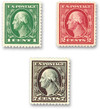
Complete Set, 1913-15 Panama-pacific Series perf 10
# 405-07 - Complete Set, 1913-15 Panama-pacific Series perf 10
$147.50
1912-14 Washington Stamps Marked Big Changes to U.S. Stamp Policy... Get the 1¢, 2¢, and 7¢ Issues Today
U.S. #405
Series of 1912-14 1¢ Washington
Series of 1912-14 1¢ Washington
Issue Date: February 1912
Printed by: Bureau of Engraving and Printing
Method: Flat plate
Watermark: Single line
Perforation: 12
Color: Green
Printed by: Bureau of Engraving and Printing
Method: Flat plate
Watermark: Single line
Perforation: 12
Color: Green
U.S. #406
Series of 1912-14 2¢ Washington
Series of 1912-14 2¢ Washington
Issue Date: February 1912
Printed by: Bureau of Engraving and Printing
Method: Flat plate
Watermark: Single line
Perforation: 12
Color: Carmine
Printed by: Bureau of Engraving and Printing
Method: Flat plate
Watermark: Single line
Perforation: 12
Color: Carmine
U.S. #407
Series of 1912-14 7¢ Washington
Series of 1912-14 7¢ Washington
Issue Date: April 29, 1914
Quantity: 5,000,000 (estimated)
Printed by: Bureau of Engraving and Printing
Method: Flat plate
Watermark: Single line
Perforation: 12
Color: Black
Quantity: 5,000,000 (estimated)
Printed by: Bureau of Engraving and Printing
Method: Flat plate
Watermark: Single line
Perforation: 12
Color: Black
In a break with tradition, Washington’s portrait replaced that of Benjamin Franklin on the 1¢ stamp of the Series of 1912-14. A new 7¢ denomination was also added to the series.
When the dies for the new series were prepared, all of them had the denominations in words and not numerals. It was pointed out, after the 1¢ and 2¢ stamps had already been issued, that this format did not conform to the Universal Postal Union’s regulations. According to their standards, the denominations were to be in numerals so they could be understood in any language. The printings for the 3¢ through $1 were held up and the plates changed to comply with U.P.U.’s guidelines. Since the one- and two-cent stamps had been released, the decision was made not to change the plates. In 1912, the denominations were finally switched to numerals.
During the years these stamps were produced, the Bureau of Printing and Engraving changed the watermarks, varied the perforations, and experimented with different types of paper. Imperforate stamps, as well as coils and booklets, were also released. The result was the printing of 175 major varieties. Although these stamps look remarkably similar, there are notable philatelic differences. The Postal Department did not regard these differences as significant, and as late as 1925, postal reports listed some issues as “Series 1908.”
1912-14 Washington Stamps Marked Big Changes to U.S. Stamp Policy... Get the 1¢, 2¢, and 7¢ Issues Today
U.S. #405
Series of 1912-14 1¢ Washington
Series of 1912-14 1¢ Washington
Issue Date: February 1912
Printed by: Bureau of Engraving and Printing
Method: Flat plate
Watermark: Single line
Perforation: 12
Color: Green
Printed by: Bureau of Engraving and Printing
Method: Flat plate
Watermark: Single line
Perforation: 12
Color: Green
U.S. #406
Series of 1912-14 2¢ Washington
Series of 1912-14 2¢ Washington
Issue Date: February 1912
Printed by: Bureau of Engraving and Printing
Method: Flat plate
Watermark: Single line
Perforation: 12
Color: Carmine
Printed by: Bureau of Engraving and Printing
Method: Flat plate
Watermark: Single line
Perforation: 12
Color: Carmine
U.S. #407
Series of 1912-14 7¢ Washington
Series of 1912-14 7¢ Washington
Issue Date: April 29, 1914
Quantity: 5,000,000 (estimated)
Printed by: Bureau of Engraving and Printing
Method: Flat plate
Watermark: Single line
Perforation: 12
Color: Black
Quantity: 5,000,000 (estimated)
Printed by: Bureau of Engraving and Printing
Method: Flat plate
Watermark: Single line
Perforation: 12
Color: Black
In a break with tradition, Washington’s portrait replaced that of Benjamin Franklin on the 1¢ stamp of the Series of 1912-14. A new 7¢ denomination was also added to the series.
When the dies for the new series were prepared, all of them had the denominations in words and not numerals. It was pointed out, after the 1¢ and 2¢ stamps had already been issued, that this format did not conform to the Universal Postal Union’s regulations. According to their standards, the denominations were to be in numerals so they could be understood in any language. The printings for the 3¢ through $1 were held up and the plates changed to comply with U.P.U.’s guidelines. Since the one- and two-cent stamps had been released, the decision was made not to change the plates. In 1912, the denominations were finally switched to numerals.
During the years these stamps were produced, the Bureau of Printing and Engraving changed the watermarks, varied the perforations, and experimented with different types of paper. Imperforate stamps, as well as coils and booklets, were also released. The result was the printing of 175 major varieties. Although these stamps look remarkably similar, there are notable philatelic differences. The Postal Department did not regard these differences as significant, and as late as 1925, postal reports listed some issues as “Series 1908.”





